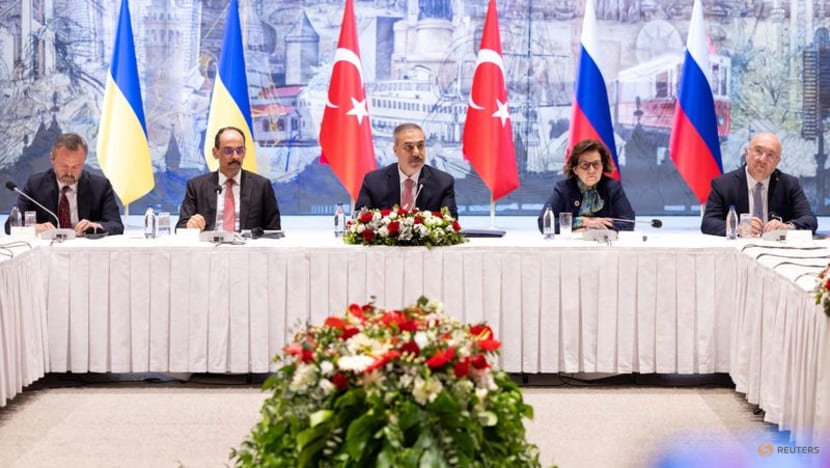Commentary: What to make of the restart in Russia-Ukraine ceasefire negotiations
Securing a prisoner swap agreement marks progress but big gaps remain on core conflict issues, says an international relations observer.

PYEONGTAEK, South Korea: Last week, Russian and Ukrainian ceasefire negotiators met face-to-face for the first time since March 2022. The location for the talks was the same as three years ago, some of the negotiators were the same, but the circumstances were vastly different from what they were.
Before, the full-scale invasion was barely a month old, the two sides had already engaged in multiple negotiating sessions, and Russian forces were still marching further into Ukrainian territory. Now, Ukraine has recaptured territory and held Russia to a stalemate through three long years of defence.
The latest talks were over relatively quickly – lasting less than two hours – and while questions abound, the two most common are what happened, and what comes next?
To answer those questions, it is first important to understand Russian behaviour vis-a-vis the restarted talks. The Kremlin has shown a bad faith approach to the resumption of ceasefire negotiations.
RUSSIA’S NEGOTIATION STRATEGY
Russian President Vladimir Putin regime waited until its forces had recaptured most of occupied Kursk before signalling its willingness to talk face-to-face with the Ukrainians. The unspoken truth was that this was to take Kursk off the table and to strengthen the Russian negotiating position.
Putin then called for a temporary ceasefire; however, unlike the Ukraine-proposed comprehensive 30-day ceasefire, it was for only three days. Rather than indicating a sincere willingness to stop the bloodshed from the conflict, the Kremlin’s unilateral declaration was tied to its Victory Day march in Moscow, a move assuredly aimed at mitigating risk to the proceedings.
During his closing speech to the Victory Day festivities, Putin called for negotiations to begin on May 15 in Istanbul. He did not identify who the Russian negotiating team would be or what they would seek to achieve. From a basic negotiating standpoint, this was a move designed to take the initiative in the ceasefire negotiation process without committing to anything.
Along the way, Russia has repeated its maximalist positions – the same terms it has parroted since 2022.
These include things like Ukraine staying out of NATO; Ukraine’s “neutral and non-aligned status”; recognition of Russian sovereignty over Crimea, Donetsk, Luhansk, Zaporizhzhia, Kherson and Sevastopol; imposing “anti-Nazi” provisions in Ukraine; and forcing the Russian language to be included as an equal in Ukraine, among others.
OUTCOME OF THE NEGOTIATION
Eventually, the Kremlin picked Vladimir Medinsky to reprise his role as lead negotiator. Medinsky served in the same role for ceasefire talks from March to May 2022, signalling the Kremlin’s attempt to pick up where they left off three years earlier when Ukraine was in a much more dire position.
Such was the setting for the latest Istanbul talks. Ukrainians assumed that Medinsky would not be coming into the latest negotiation with authority to do much, so they focused on three core objectives for the talks.
Defence Minister Rustem Umerov represented the Ukrainian side in working to secure a 30-day ceasefire, an all-for-all prisoner of war exchange and a meeting between Presidents Volodymyr Zelenskyy and Putin.
Predictably, Medinsky used the session to repeat Russia’s maximalist demands. He rejected the 30-day ceasefire and later remarked that “war and negotiations have always happened at the same time.”
Despite the two sides being far apart on broader issues, they did manage to come to some agreements. Most notably was securing a 1,000-for-1,000 prisoner of war exchange, which is progress on a key focus area for the Ukrainian Peace Formula.
They also agreed to exchange their respective lists of positions vis-a-vis the ceasefire and, importantly, that the two sides will meet again.
UKRAINE’S MISSED OPPORTUNITIES
While any progress is better than no progress, there were missed opportunities.
First, Ukraine and its partners could have anticipated that Russia would reject the 30-day ceasefire proposal and had some form of punitive response prepared. While many have decried the Russians for prolonging the killing, the behaviour will go unchecked until there are additional costs imposed.
Second, the Ukrainians could have delivered a fully formed draft agreement to serve as a new anchor for the talks. This draft would create a new starting point for discussions and would have been an effective means of shifting initiative in the negotiation to the Ukraine side.
Third, Ukraine’s partners could have had some announcement about aid ready to deploy upon completion of the Istanbul talks. The objective would have been to signal to the Russian side that the longer it drags out ceasefire negotiations, the more support the Ukrainians will have.
In the days since the talks wrapped up, movement has been slow. The European Union is reportedly looking at new sanctions packages, but nothing has been implemented.
US President Donald Trump held a two-hour call with Putin where they reaffirmed the importance of negotiations but did not indicate any fundamental shift in Russia’s approach to the ceasefire process.
Meanwhile, the safe money says that Russia will try to ratchet up military pressure while holding firm on its demands. The Kremlin is probably gambling on the notion that they do not need to outlast Ukraine, they just need to outlast foreign support to Ukraine.
Michael MacArthur Bosack is the special adviser for government relations at the Yokosuka Council on Asia-Pacific Studies and founder of the Parley Policy Initiative. This article was first published on Lowy Institute's The Interpreter.














